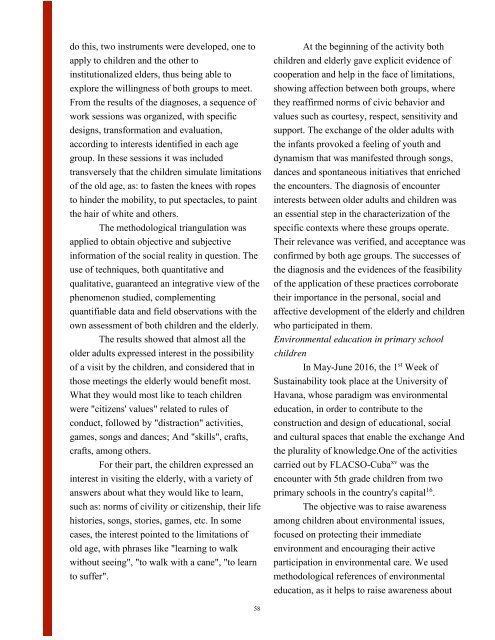CLC-Conference-Proceeding-2018
Create successful ePaper yourself
Turn your PDF publications into a flip-book with our unique Google optimized e-Paper software.
do this, two instruments were developed, one to<br />
apply to children and the other to<br />
institutionalized elders, thus being able to<br />
explore the willingness of both groups to meet.<br />
From the results of the diagnoses, a sequence of<br />
work sessions was organized, with specific<br />
designs, transformation and evaluation,<br />
according to interests identified in each age<br />
group. In these sessions it was included<br />
transversely that the children simulate limitations<br />
of the old age, as: to fasten the knees with ropes<br />
to hinder the mobility, to put spectacles, to paint<br />
the hair of white and others.<br />
The methodological triangulation was<br />
applied to obtain objective and subjective<br />
information of the social reality in question. The<br />
use of techniques, both quantitative and<br />
qualitative, guaranteed an integrative view of the<br />
phenomenon studied, complementing<br />
quantifiable data and field observations with the<br />
own assessment of both children and the elderly.<br />
The results showed that almost all the<br />
older adults expressed interest in the possibility<br />
of a visit by the children, and considered that in<br />
those meetings the elderly would benefit most.<br />
What they would most like to teach children<br />
were "citizens' values" related to rules of<br />
conduct, followed by "distraction" activities,<br />
games, songs and dances; And "skills", crafts,<br />
crafts, among others.<br />
For their part, the children expressed an<br />
interest in visiting the elderly, with a variety of<br />
answers about what they would like to learn,<br />
such as: norms of civility or citizenship, their life<br />
histories, songs, stories, games, etc. In some<br />
cases, the interest pointed to the limitations of<br />
old age, with phrases like "learning to walk<br />
without seeing", "to walk with a cane", "to learn<br />
to suffer".<br />
At the beginning of the activity both<br />
children and elderly gave explicit evidence of<br />
cooperation and help in the face of limitations,<br />
showing affection between both groups, where<br />
they reaffirmed norms of civic behavior and<br />
values such as courtesy, respect, sensitivity and<br />
support. The exchange of the older adults with<br />
the infants provoked a feeling of youth and<br />
dynamism that was manifested through songs,<br />
dances and spontaneous initiatives that enriched<br />
the encounters. The diagnosis of encounter<br />
interests between older adults and children was<br />
an essential step in the characterization of the<br />
specific contexts where these groups operate.<br />
Their relevance was verified, and acceptance was<br />
confirmed by both age groups. The successes of<br />
the diagnosis and the evidences of the feasibility<br />
of the application of these practices corroborate<br />
their importance in the personal, social and<br />
affective development of the elderly and children<br />
who participated in them.<br />
Environmental education in primary school<br />
children<br />
In May-June 2016, the 1 st Week of<br />
Sustainability took place at the University of<br />
Havana, whose paradigm was environmental<br />
education, in order to contribute to the<br />
construction and design of educational, social<br />
and cultural spaces that enable the exchange And<br />
the plurality of knowledge.One of the activities<br />
carried out by FLACSO-Cuba xv was the<br />
encounter with 5th grade children from two<br />
primary schools in the country's capital 16 .<br />
The objective was to raise awareness<br />
among children about environmental issues,<br />
focused on protecting their immediate<br />
environment and encouraging their active<br />
participation in environmental care. We used<br />
methodological references of environmental<br />
education, as it helps to raise awareness about



